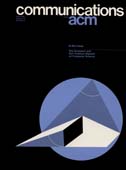ACM president’s letter: eating our seed corn
On July 12 and 13, 1980, the biennial meeting of Computer Science Department chairmen was held at Snowbird, Utah. This meeting, which is organized by the Computer Science Board (CSB), is a forum for the heads of the 83 departments in the United States and Canada that grant Ph.D.s in Computer Science. The meeting was attended by 56 department heads or their representatives, and by six observers from industry and government. This report was developed during the meeting as a result of intensive discussions about the crisis in Computer Science. This report was endorsed by the entire assembly.




